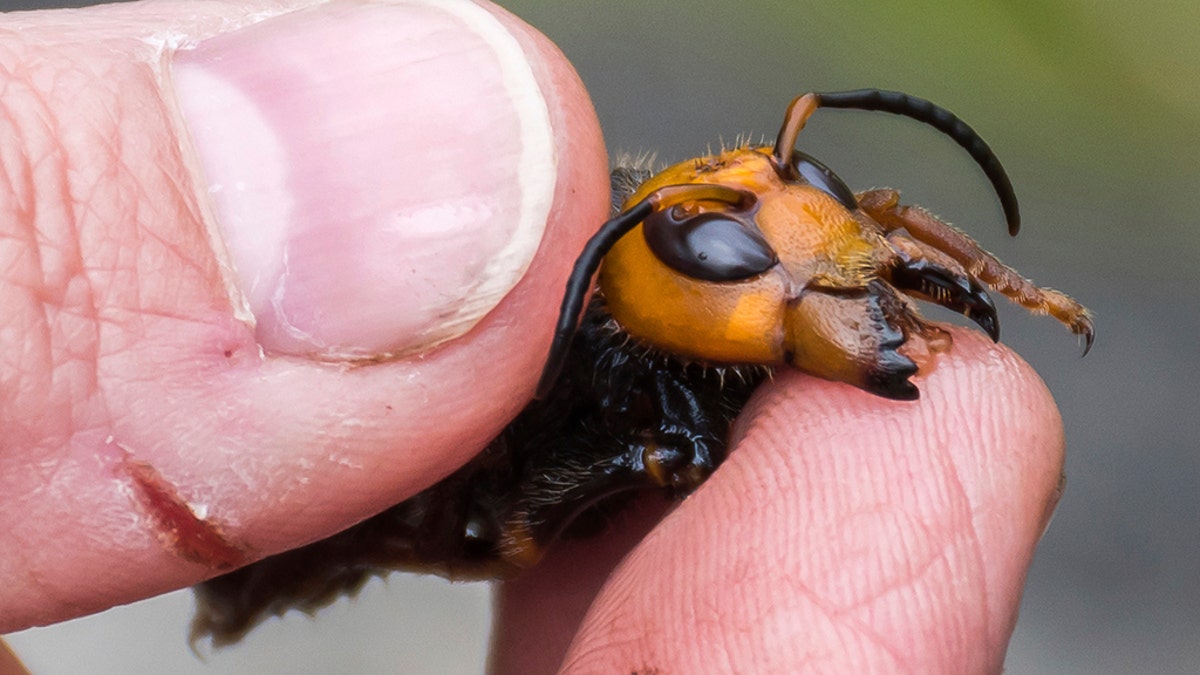'Murder hornets' pose risk to honey bee population
'Murder hornets' spotted for first time in U.S.; Noah Wilson-Rich, for the Best Bees Company, speaks out.
Murder hornets have a new name in the state of Washington.
The invasive insect, which is also known as the Asian giant hornet, has been classified as the northern giant hornet by the Entomological Society of America (ESA).
The name has been added to the ESA’s Common Names of Insects and Related Organisms List.
Experts at the Washington State Department of Agriculture announced that they’ll go with the ESA’s naming for the Vespa mandarinia species, on Monday, July 25.
SCIENTISTS IN US, CANADA GEAR UP FOR BATTLE AGAINST MURDER HORNETS
Print and digital resources that mention murder hornets or Asian giant hornets will be updated to say northern giant hornet instead.

In this photo provided by the Washington State Dept. of Agriculture, an Asian Giant Hornet wearing a tracking device is shown Thursday, Oct. 22, 2020 near Blaine, Wash. (Karla Salp/Washington Dept. of Agriculture via AP)
The update to the "newly established ESA common name" will be reflected "in the coming weeks," according to the agriculture department.
"The new official common names are intended to comply with ESA’s insect common names guidelines, which include avoiding naming insects using geographic regions," the department’s press release states.
It continued, "The new names should also help reduce confusion between V. mandarinia – which had been known as Asian giant hornet – and V. velutina – which had been known as the Asian hornet."
PRAYING MANTIS EATS MURDER HORNET IN FRIGHTENING VIDEO
Dr. Chris Looney, an entomologist at the Washington State Department of Agriculture’s Olympia Lab was involved the hornet’s renaming.
He reportedly proposed the northern giant hornet name, and he’s also proposed that the Vespa soror species should be named the southern giant hornet and Vespa velutina species should be named the yellow-legged hornet to minimize confusion.

In this April 23, 2020, photo provided by the Washington State Department of Agriculture, a researcher holds a dead Asian giant hornet in Blaine, Wash. (Karla Salp/Washington Dept. of Agriculture via AP)
Resources on the USDA still refer to northern giant hornets as Asian giant hornets.
The hornet species often target honey bees but can sometimes sting humans.
WASHINGTON STATE RECORDS FIRST LIVE MURDER HORNET SIGHTING IN US
"Asian giant hornets (northern giant hornets) are extremely large hornets that range in size from 1.5 to over 2 inches long," the USDA said. "They are equipped with relatively massive mandibles (teeth) and can easily tear honey bees in half."
"Usually, these hornets will not attack honey bees until late summer or early fall, when workers are feeding new queens and males within the colony that will emerge to mate in the fall," the USDA continued.

In this Oct. 24, 2020, file photo, Sven Spichiger, Washington state Department of Agriculture managing entomologist, displays a canister of Asian giant hornets vacuumed from a nest in a tree behind him in Blaine, Wash. (AP Photo/Elaine Thompson)
Northern giant hornets were first spotted in Washington during the winter of 2019. Reports on the insect became widespread throughout North America in 2020, including the U.S. and British Columbia, Canada.
CLICK HERE TO GET THE FOX NEWS APP
Entomologists at the Washington State Department of Agriculture have eradicated four northern giant hornet nests so far.


